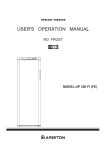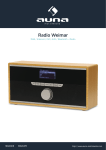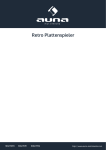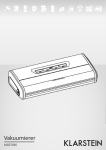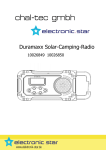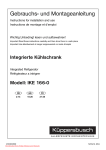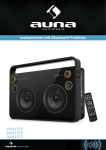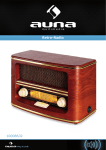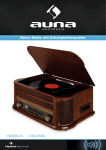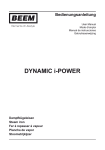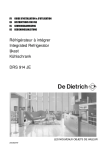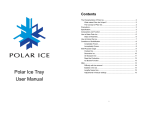Download Kühlschrank BC-50
Transcript
Kühlschrank BC-50 10006674 Sehr geehrter Kunde, zunächst möchten wir Ihnen zum Erwerb Ihres Gerätes gratulieren. Bitte lesen Sie die folgenden Anschluss- und Anwendungshinweise sorgfältig durch und befolgen Sie diese um möglichen technischen Schäden vorzubeugen. Sicherheitshinweise • • • • • Kinder sollten während der Benutzung des Geräts beaufsichtigt werden. Beim Abtauchen dürfen keine mechanischen Hilfsmittel verwendet werden. Vermeiden Sie Beschädigungen des Kühlkreislaufes. Betreiben Sie keine anderen elektrischen Geräte innerhalb des Kühlschranks. Nur für den Hausgebrauch. Geräteübersicht 1. 2. 3. 4. 5. 6. 7. Einstellbare Standfüße Temperaturegler Tropfschale Entnehmbare Böden Gefrierfach Ablagefach Flascheablage Aufbauhinweise • Gut belüftet Eine gute Belüftung ist für eine zufriedenstellende Kühlung wichtig. Halten Sie einen Mindestabstand zur Wand von 10mm ein, zu den beiden Seiten von 100mm und nach oben 200mm ein. Die Tür sollte bis zu einem Winkel von 160° geöffnet werden können. • Stromversorgung Der Kühlschrank benötigt eine Netzspannung AC 220-240V/50Hz. Prüfen Sie diesen vor dem Anschluss. Achten Sie darauf, dass Sie eine geerdete Steckdose verwenden. 2 • Netzkabel Das Netzkabel darf nicht geknickt oder überdehnt werden. Es darf auch nicht in der Nähe des Kompressors verlegt werden. Halten Sie es auch von anderen Hitzequellen fern. • Schutz vor Nässe Das Gerät darf nicht hoher Luftfeuchtigkeit oder Spritzwasser ausgesetzt werden. Die Metallteile können rosten und die elektrischen Bauteile Schaden nehmen. • Schutz vor Hitze Halten Sie das Gerät fern von Hitze oder direkter Sonnenstrahlung • Stabiler stand Der Standort muss eben und stabil sein. Es dürfen keine weichen Unterlagen wie z.B. Styropor verwendet werden. Stellen Sie wenn nötig die Standfüße ein. • Gefahrstoffe verhalten Stellen Sie niemals Gefahrstoffe wie Benzin, Alkohol oder Öl in oder in die Nähe des Kühlschranks. • Transport Während des Transports darf der Kühlschrank nicht über 45° geneigt oder sogar umgedreht werden. 3 Bedienungshinweise • • • • • Wartung & Reinigung • • • • • Durch die bei geöffneter Tür eintretende Luftfeuchtigkeit kann sich eine Eisschicht bilden. Diese mindert die Kühlleistung. Ist die Schicht dicker als 2mm, muss der Kühlschrank abgetaut werden. Der Kühlschrank muss manuell abgetaut werden. Entnehmen Sie vor dem Abtauen alle Lebensmittel, den Eiswürfelbehälter und die Ablage. Stellen Sie den Temperaturregler auf „0“ (der Kompressor ist nun ausgeschaltet) und lassen Sie die Tür offen stehen. Nachdem das Eis geschmolzen ist, wischen Sie das Wasser aus dem Gerät. Zum schnelleren abtauen können Sie eine Schale mit warmen Wasser (ca. 50°C) ist das Gerät stellen. Sie dürfen das Gerät nicht mit einem elektrischen Heizgerät abtauen, da sich durch die heiße Luft die Innenverkleidung verformen kann. Kratzen Sie auch kein Eis mit scharfen oder spitzen Gegenständen aus dem Gerät. Da hierdurch das Gehäuse oder der Kühlkreislauf beschädigt werden kann. Sollte das Netzkabel beschädigt sein, muss dieses umgehend von einem Fachmann neuert werden. Der Gefrierschrank sollte einmal im Monat gereinigt werden. Trennen Sie das Gerät vor der Reinigung bzw. Wartung vom Stromnetz. Reiben Sie das Gerät mit einem feuchten Tuch aus. Falls nötig kann zusätzlich ein mildes Reinigungsmittel verwendet werden. Wischen Sie das mit klarem Wasser nach und trocken die Flächen. Verwenden Sie zum Reinigen kein heißes Wasser, Lösungsmittel, Benzin, Alkohol, Wasserpulver oder andere starken Chemikalien. Das diese zu Schäden an der Innenverkleidung führen. Verwenden Sie auch kein fließendes Wasser. Behandeln Sie die Gummidichtung an der Tür sorgsam. Auch diese sollte gereinigt werden. Türanschlag ändern Sie können den Türanschlag wie auf diesem Bild zu sehen ändern. 4 Fehlerbehebung Problem Mögliche Lösung • Gerät ohne Funktion. • Stromversorgung prüfen. • Netzstecker auf richtigen Sitz prüfen. • Gerät kühlt zu stark. • Zu hohe Stufe eingestellt. • Mit Lebensmittel kann Feuchtigkeit in das Gerät kommen. Dieses erhöht die Kühlleistung. • Gerät kühlt zu wenig. • Lebensmittel verdecken den Luftauslass. • Sie haben zu viele warme bzw. zu heiße Dinge in den Kühlschrank gelegt. • Tür nicht richtig geschlossen. • Türdichtung beschädigt. • Gerät nicht ausreichend belüftet. • Mindestabstand zu den Seiten nicht eingehalten. • Falsche Kühlstufe eingestellt. • Das Wasser läuft beim Abtauen aus dem Gerät. • Prüfen Sie den Abstand inkl. Schlauch auf Verstopfungen. • Prüfen Sie ob den Schlauch am Ablauf sitzt. • Die Front des Kühlschranks heizt sich auf. • Um Kondenz zu vermeiden, leitet ein Schlauch warme Luft zur Front und diese wird hierdurch aufgewärmt. • Es bildet sich Kondenz am Geräteäußeren. • Kondenz ist bei hoher Luftfeuchtigkeit normal. Reiben Sie das Gerät mit einem Tuch trocken. • Geräusch wie fließendes Wasser zu hören. • Diese ist das normale Betriebsgeräusch. • Die Seiten des Kühlschranks heizen sich auf. • Die Tür könnte in kurzer Zeit zu häufig geöffnet worden sein. Eine andere Ursache könnte eine hohe Umgebungstemperatur sein. Fassen Sie die heißen Oberflächen nicht an. 5 SICHERHEITSHINWEISE UND GEWÄHRLEISTUNG • Diese Bedienungsanleitung dient dazu, Sie mit der Funktionsweise dieses Produktes vertraut zu machen. Bewahren Sie diese Anleitung daher stets gut auf, damit Sie jederzeit darauf zugreifen können. • Sie erhalten bei Kauf dieses Produktes zwei Jahre Gewährleistung auf Defekt bei sachgemäßem Gebrauch. • Bitte verwenden Sie das Produkt nur in seiner bestimmungsgemäßen Art und Weise. Eine ander weitige Verwendung führt eventuell zu Beschädigungen am Produkt oder in der Umgebung des Produktes. • Ein Umbauen oder Verändern des Produktes beeinträchtigt die Produktsicherheit. Achtung Verletzungsgefahr! • Öffnen Sie das Produkt niemals eigenmächtig und führen Sie Reparaturen nie selber aus! • Behandeln Sie das Produkt sorgfältig. Es kann durch Stöße, Schläge oder den Fall aus bereits geringer Höhe beschädigt werden. • Halten Sie das Produkt fern von Feuchtigkeit und extremer Hitze. ACHTUNG: Es wird keine Haftung für Folgeschäden übernommen. Technische Änderungen und Irrtümer vorbehalten! Der Hersteller dieses Produktes ist die CHAL-TEC Vertriebs- + Handels GmbH, Wallstraße 16, 10179 Berlin. Konformitätserklärung Dieses Produkt entspricht den folgenden Europäischen Richtlinien: 2004/108/EG (EMV) 2006/95/EG (Niederspannung) 2011/65/EU (RoHS) Elektroaltgeräte Befindet sich die obige Abbildung (durchgestrichene Mülltonne auf Rädern) auf dem Produkt, gilt die Europäische Richtlinie 2002/96/EG. Diese Produkte dürfen nicht mit dem normalen Hausmüll entsorgt werden. Informieren Sie sich über die örtlichen Regelungen zur getrennten Sammlung elektrischer und elektronischer Gerätschaften. Richten Sie sich nach den örtlichen Regelungen und entsorgen Sie Altgeräte nicht über den Hausmüll. Durch die regelkonforme Entsorgung der Altgeräte werden Umwelt und die Gesundheit ihrer Mitmenschen vor möglichen negativen Konsequenzen geschützt. Materialrecycling hilft, den Verbrauch von Rohstoffen zu verringern. Viel Spaß mit unserem Produkt. Warnhinweise • • • • • • • • Reparaturen am Gerät sollten nur von einer autorisierten Fachwerkstatt durchgeführt werden. Öffnen Sie in keinem Fall das Gerät. Falscher Zusammenbau führt möglicherweise zu Fehlfunktionen oder dem Totalausfall. Das Gerät sollte vor jeglichen Feuchtigkeit und direkter Sonneneinstrahlung geschützt werden. Das Gerät bitte nicht mit Reinigungsmitteln reinigen. Verwenden Sie zur Reinigung nur ein trockenes (Mikrofaser) Tuch. Schließen Sie das Gerät nur an die dafür vorgesehene Netzspannung. Schließen Sie das Gerät in keinem Fallan andere Spannungen als vorgesehen an. Die Gewährleistung verfällt bei Fremdeingriffen in das Gerät. 6 Warning • • • • • Children should be supervised to ensure that they do not play with the appliance. Do not use mechanical devices or other means to accelerate the defrosting process, other than those recommended by the manufacturer. Do not damage the refrigerant circuit. Do not use electrical appliances inside the food storage compartments of appliance, unless they are of the type recommended by the manufacturer. House hold used only. Name of parts 1. 2. 3. 4. 5. 6. 7. Adjustable Foot Temperature Control Knop Drip Tray Removable Shelves Freezer Compartment Dairy Rack Bottle Rack Correctly positioning • Well Ventilating There is need of good ventilation around the refrigerator for easy dissipation of heat, high efficiency of refrigeration and low power consumption. For this purpose, sufficient clear space should be needed around the refrigerator. Its back is at least 10mm away from the wall. Its sides at least have a space of 100mm separately andThe height from over a top is not less than 200mm. A clear space should be left to open the door to 160°. • Power Supply The refrigerator is only applied with power supply of single phase alternating current of 220-240V/50Hz if fluctuation of voltage in the distinct user is of so large that the voltage onwards the above scope. For safety sake, be sure to apply A.C automatic voltage regulator to the refrigerator. The refrigerator must employ a special power socket instead of common one with other electric appliance. Its plug must match the socket with ground wire. • Power Line Cord The cord should be neither lengthened nor folded into coil during operation. Moreover, it id forbidden that cord is kept close onto the compressor at the back of the refrigerator. The surface temperature of which is quite high when operating. Touching with it would deactivate the insulation on cause leakage for electricity. 7 • Protection From Moisture Avoiding placing the refrigerator in a place where heavy moisture is present so as to minimize possibly of rusty for its metal parts still more, the refrigerator is forbidden to be directly sprayed by water. Otherwise, poor insulation and current leakage would occur. • Protection From Heat The refrigerator should be far away from any heat source or direct sunshine. • Fixing Stable Floor on which refrigerator will be placed must be flat and bold. It should not be laid on any soft material such as foam plastic, etc. If the refrigerator is not on the same level. Adjust the screw suitably. The refrigerator should not be placed near anything which may echo. • Behave hazardous substances It is inadvisable that the refrigerator is placed near any vitalization or combustibles such as gas, patrol, alcohol, lacquer and banana oil etc. The above-mentioned objects can not be stored in the refrigerator. • Moving When fixed or moved, the refrigerator can not be set horizontally or declined to more then 45° or upside-down. Cautions • What contained in fold or getting into air inside the refrigerator by opening doors may form a layer of frost inside. It will weaken the refrigerator when the frost is thick while it is more than 2mm thick, you should defrost. • Defrosting in freezer chamber is operated manually. Before defrosting, take the food, the ice tray and the shelf out into the cold storing chamber separately, then set the knob of the temperature regulator to position “0” (where the compressor will stop working and leave the door open unit ice and frost dissolve thoroughly deposited at bottom of the freezer chamber) wipe off the water with soft cloth in the case of speeding up the defrosting. You may put a bowl of warm water (about 50°C) into thefreezer chamber and be sure to set the knob of the temperature regulator to orignal position after defrosting. • It’s inadvisable to be heat freezer chamber directly, with hot water or high dryer while defrosting to present deformation of the inner case. 8 • It’s also inadvisable to scrape of ice frost or separate food from the containers which have been congealed together with the food with sharp load or wooden bars. So as not to damage the inner casing or the surface of the evaporator. • If the supply cord of the appliance is damaged, it must only be replaced by a repair shop appoited by the manufacturer. Because special purpose tools are required Maintenance • • • • • The refrigerator should be cleaned and maintained once a month. When performing maintenance, make absolutely sure that the power plug is first disconnected from the power outlet. Wipe the inner and outer surface of the refrigerator and its accessories with wet cloth, if they are too dirty, scrub them with neutral detergent and then clean them with water and dry them with clean cloth. After this, a small quantify of glass wax is recommended to polish the refrigerator surface with a flannelette. For cleaning don’t use hot water, diluent, petrol, alcohol, kerosene, washing powder, cleanser, alkalinous detergent, acid, chemical cloth, etc. So as not damaged the lacquer coat and plastics. It is forbidden than the refrigerators directly with water. Otherwise, it would cause rusty or weaken the insulation. Be careful to upkeep the sealing rubber bars of the doors. They should always be cleaned. Door Reversal Instructions In order to reverse the opening direction of your door, please follow these simple instructions. 9 Trouble Shooting Problem Possible Solution • When the refrigerator does not work • Check if there is a power failure. • Check if the power plug is plugged into power outlet. • When the refrigerator is coo- • The temperature control dial may be set too high. ling excessively. • If you place foodstuffs containing a lot of moisture directly under the cool air outlet, they will freezer easily. This does not indicate a malfunction. • When the refrigerator is not • The food may be packed too tightly together which will block the cooling sufficiently. flow of cool air. • You may have put something hot or a lot of foodstuffs into the refrigerator. • The door may not have been closed properly. • The door gaskets may be damaged. • The refrigerator may not be ventilated. • There may be insufficient clearance between the refrigerator and the surfaced immediately both sides and above. • The temperature control dial may not be set properly. • When the defrosting water • Checks that the drain pipe and drain hose are not clogged. overflows inside the refrigera- • Check that the drain pan is house properly. tor and onto the floor. • When the refrigerator’s cabi- • In order to safeguard against condensation, there is an anti condennet front heats up. sation pipe which heats up the cabinet front when running actuated. A warm cabinet front does not indicate a malfunction. • When condensation form on the outside of the refrigerator. • Condensation may form on the outside when the humidity is high such as during a wet season. This is the same result as the condensation formed when chilled water is poured into a glass. It does not, therefore, indicate a failure, wipe dry with a dry cloth. • When you hear a sound like • A sound like water flowing is the refrigerant flowing. It doesn’t indiwater flowing. cate a malfunction. • When the cabinet’s side panel • The side panel of the cabinet will heat up when the door is opened or heats up. closed frequently. When starting the unit and when the unit operates in summer with high ambient outside temperature. In such case, do not touch the panel, it results from the dissipation of the heat from inside the cabinet, and it does not mean that something is wrong with the refrigerator. 10 The manufacturer of this product is CHAL-TEC Vertriebs- + Handels GmbH, Wallstraße 16, 10179 Berlin, Germany This product complies with the requirements of the directives 2004/108/EC (EMC) 2006/95/EC (LVD) 2011/65/EU (RoHS) Electric and electronic equipment and included batteries contains materials, componentsans substances that can be hazardous to your health and the enviroment, if the waste material (discarded electric and electronic equipment and batteries) is not handled correctly. Electric and electronic equipment and batteries is marked with the crossed ou trash can symbol, seen here. This symbol signifies that electric and electronic equipment and batteries should not be disposed of with other household waste, but should be disposed of separately. As the end user it is important that you submit your used batteries to the appropriate and designated facility. In this manner you make sure that the batteries are recycled in accordance with legislature and will not harm the enviroment. All cities have established collection points, where electric and electronic equipment and batteries can either be submitted free of charge at recycling stations and other collection sites, or be collected from the households. Additional information is available at the technical department of your city. 11











